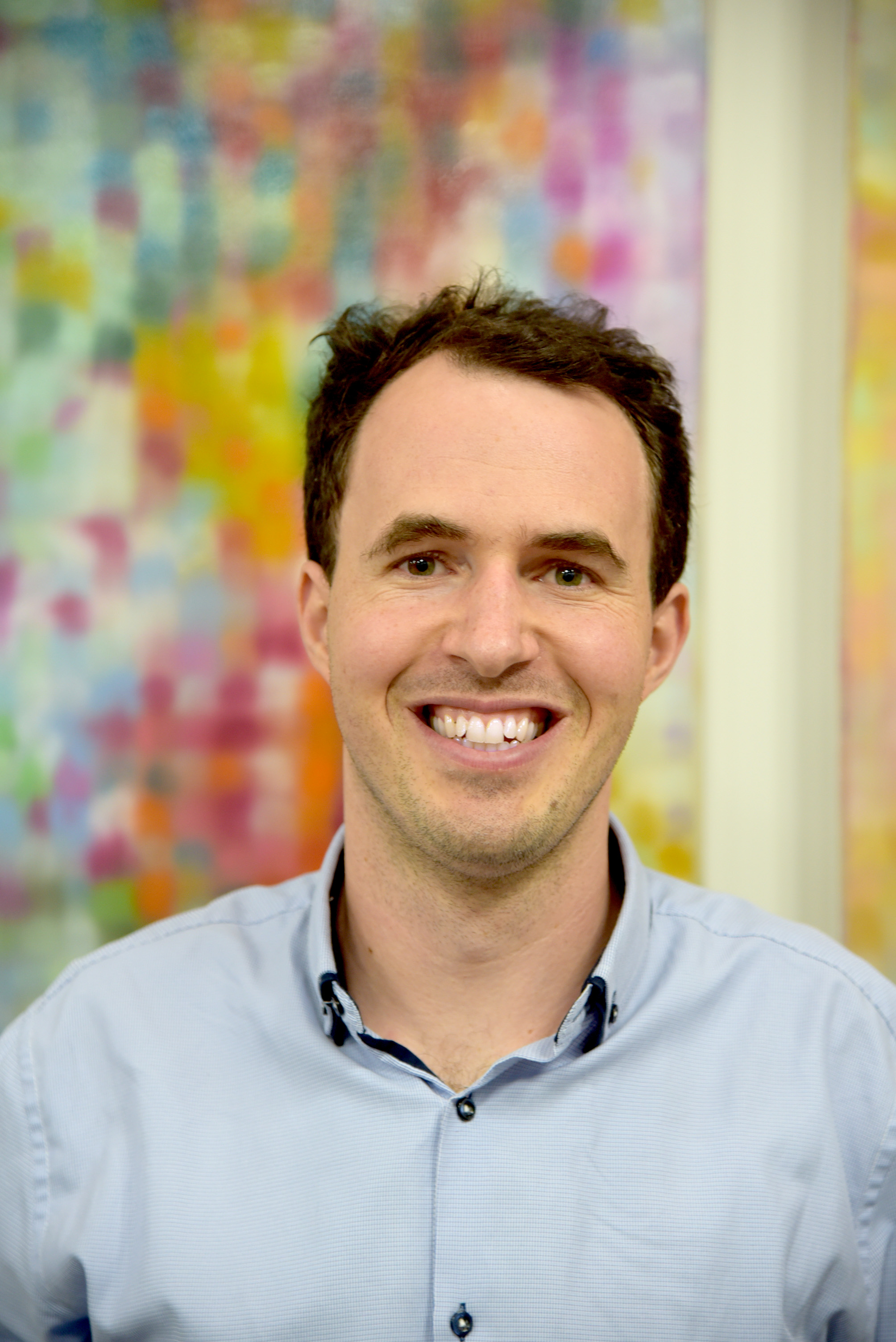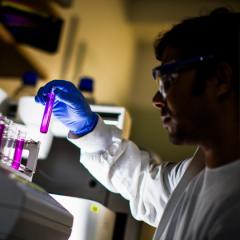Four letters, a single molecular strand, and a new realm of therapeutic possibilities. Welcome to the world of mRNA - a field responsible for two Covid-19 vaccines - and a frontier that Dr Seth Cheetham is charting with gusto.

Seth is one of the more recent additions to the Australian Institute for Bioengineering and Nanotechnology (AIBN) at The University of Queensland where he heads up his own research group and is the scientific and partnerships lead of the BASE mRNA facility.
An NHMRC Early Career Fellow and the recent recipient of an ARC Discovery Early Career Researcher grant, Seth oversees a range of innovative research programs and partnerships involving mRNA technologies and their applications in health.
“People have known about mRNA for some time but really it’s a field that we’re only just scratching the surface of,” he says.
Read on to find out about messenger molecules, Seth’s scientific parents, Cambridge, fruit flies, and how the team at BASE has the potential to change the world.
--
Seth, for the uninitiated, what is mRNA and why should we care?
At the most basic level, mRNA is a single-stranded molecule in our cells that carries information to inform protein production.
The ‘m’ in ‘mRNA’ literally stands for messenger.
Each mRNA molecule has instructions that describe how it should be handled by the cell, and what proteins should be made.
I mean, the whole field is incredibly new. We’ve been aware of mRNA molecules since the 1960s but it’s only been in the last decade that we’ve really began to work on mRNA therapeutics and such.
Why do we hear ‘mRNA’ and ‘vaccines’ often mentioned in the same sentence?
The production of mRNA vaccines is where the hype is at the moment. The trailblazing success of the Covid-19 vaccines has really gotten everyone talking about it.
I guess to start with, most drugs that people are aware of are usually made up of proteins, or small chemical molecules. So, when you’ve traditionally immunised someone you’ve injected them with a protein from a virus or an inactivated virus, which then trains the immune system to recognise it and fight it.
The breakthrough with mRNA vaccines is that, instead of injecting someone with virus proteins, we’re injecting them with information that encodes those proteins.
The cells themselves then make the protein, which the immune system recognises and fights.
Are mRNA vaccines a better process?
The big thing is that mRNA vaccines are much quicker to develop. We saw that with the Covid-19 vaccines.
The reason it’s quicker is that every mRNA vaccine is essentially made in much the same way.
You don't have to redesign the manufacture pipeline for different diseases, which is essentially what is required when you’re manufacturing different proteins.
Moderna and Pfizer were quickly able to roll out their Covid vaccine because they already had all that mRNA infrastructure in place. They weren’t initially working on Covid-19 - because they didn't know it existed – but they were working on other mRNA vaccines. They were able to adapt.
And you can keep adapting an mRNA vaccine as you go. Australia has already approved next-generation Covid vaccines which are based on the Omicron sequence.
This ability to quickly adapt to circulating strains is going to be key in the future fight against Covid.
Where does the AIBN and BASE come into all this?
Our work at BASE is all about mRNA. Both in the research we do and the services we offer.
Through a partnership between Therapeutics Innovation Australia (TIA) and The University of Queensland (UQ) we are able support the design and manufacture of mRNA vaccines and therapies for Australian researchers.
So far we’ve built more than 40 mRNA (65 mg) vaccines, therapies, and reagents for use by our scientific, clinical, and industry partners.
Do you think we’ll see mRNA vaccines continue to grow?
There are only two mRNA vaccines so far that are widely approved in the world, the Moderna and Pfizer vaccines. So, it’s still early days. 
That said, I think it's been estimated that there's about 1500 clinical trials currently underway. So, the mRNA field is just exploding.
Whether it ends up being the dominant kind of vaccine modality remains to be seen. Now, we've only really got strong data on targeting one disease. I do predict it will occupy a large slice of the vaccine market in the future.
How did you come to be working in this field?
My parents worked as biologists at the University of New England in Armidale, where I grew up. So, I guess science has been a bit of a family business.
I eventually studied biochemistry and genetics at UQ and I was fortunate enough to do honours with Prof. John Mattick at the Institute of Molecular Biology. I wasn’t really into biology until university, I was more interested in things like chemistry. But once I started the practicals of biology I found that much more engaging.
I did my PhD at the University of Cambridge in the UK, which looked at non-traditional roles for RNAs in nervous system development. It's quite basic biology. I was working on fruit flies.
Fruit flies?
Yeah, it sounds weird but fruit flies have a lot of good characteristics for research.
The genetic tools that you can use on them are good, they're very easy to keep because they're very small and, while they have a complex nervous system, its reasonably tractable to understand it.
Noted. So, you get your PhD in the UK and then you come back here?
Yes I came back to Queensland in 2017 and got a postdoc position with the Genome Plasticity and Disease research group at Mater Research, led by Professor Geoff Faulkner. I got a NHMRC Early Career Fellowship which allowed me to have independent projects and, four and a bit years later, I got the position with AIBN and BASE.
Can you talk us through your current work at BASE?
My group tends to take a quite foundational approach to mRNA technologies, where we work on the technology itself, as well as distinct applications of it.
mRNA technology came through quickly. So, there’s basically only one way of doing things that’s been established. But there’s a multitude of mRNA research that’s been happening over the last decades. And we’re really looking at integrating some of the findings from that basic research, which was never designed to be applied to mRNA vaccines, but now we can take all that knowledge and start to design better mRNA therapies and vaccines.
Some of the applications that we’re looking at are quite novel, so we’re not just looking at like things like vaccines, we’re looking at using mRNAs to improve cell therapies. That’s where you take cells from someone or you grow cells in the lab and you put them into an individual as a treatment.
Can you give us an example of a disease where this might work?
The most common example is in cancer. You can take cells out of patients and train them to recognise cancer cells, and then put them back into a patient and then those cells will go and find and eliminate cancer. So, we’re looking at applying mRNA technology to basically design these synthetic molecules that will enable immune cells to go back inside your body and eliminate and seek it out.
Some other applications that we’re looking at are using mRNA to be able to manufacture particular kinds of cells in the lab. For example, there’s a wealth of research that suggests that putting heart cells back into patients after they’ve had a heart attack can be effective at helping their recovery. But producing a large enough quantity and purity of those cells in the lab is actually very challenging. And we believe that by putting in synthetic RNA is we can guide the process of differentiation so that we end up with a very pure product of cells that will then be able to use to put back into a patient.
Sounds like BASE is really at the vanguard of what’s happening in mRNA?
Yeah, I think so. The team at BASE has been very successful in setting up mRNA production. Now we're essentially the only mRNA facility in town that's actively producing mRNA, and we're supplying that to researchers and companies in Australia, and New Zealand. Obviously, that will expand over time. But we were definitely very fast at kind of getting it up and running.
I guess I'm just incredibly excited to start to apply some of the RNA biology that we've learned to improve therapies. I think the intersection of cell therapies and mRNA technologies is a really exciting, new area.
It's fairly blue-sky research at the moment but in two or three years we'd definitely be looking at trying to move some of this research towards initiating clinical trials to start to test the safety and efficacy of mRNA-based cell therapy approaches.



